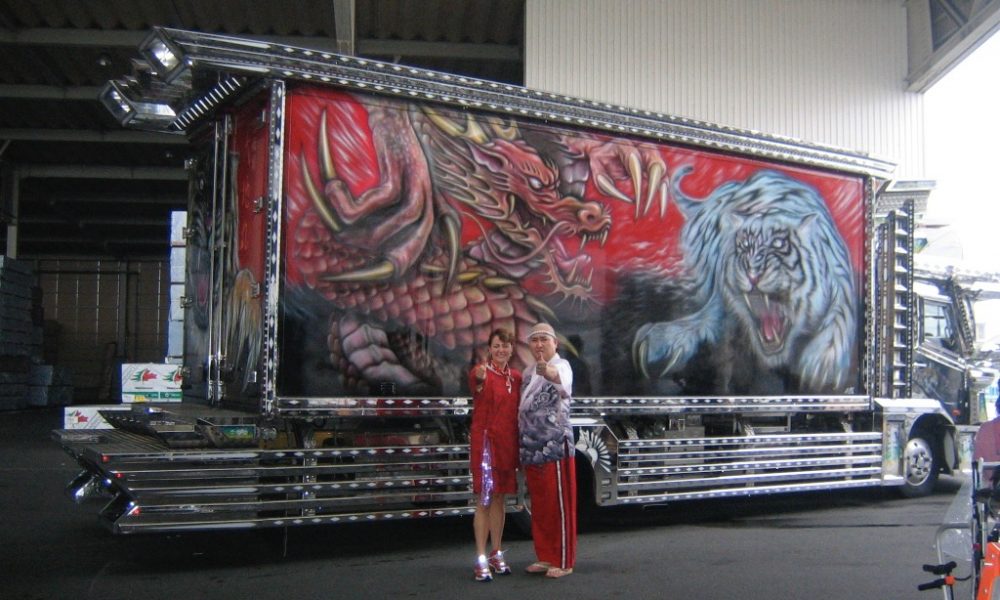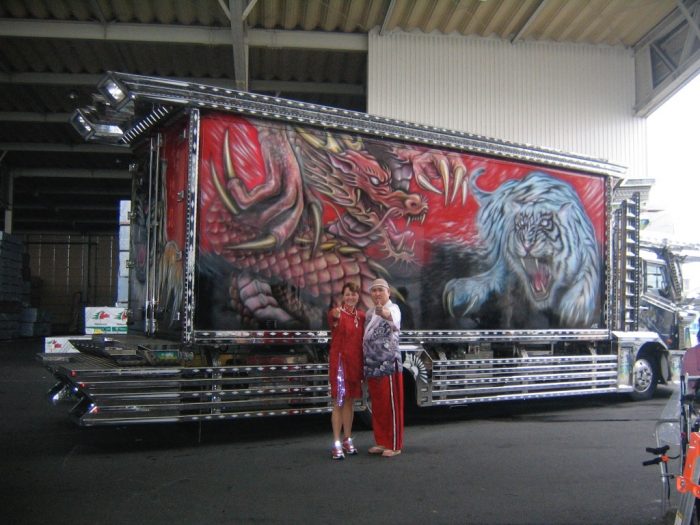
Others: Dekotora movie characters Cute Cool Dekotoras II
By Judit Kawaguchi
One or two takes and it’s a wrap!
Speed is one trait that, Tame chan, the movie’s easygoing producer values highly and the whole film was shot in just 14 short days! No wonder, since most scenes were done in only one or two takes. That is quick! It took Marilyn Monroe 47 takes to say a perfect “It’s me, Sugar!” and 59 to a great “Where’s the bourbon?” in the hilarious 1959 Billy Wilder movie, Some Like It Hot. The Tame Chan Crew likes it fast and our photographer, Ms. Ishikawa and I were there for 3 exciting days of great moviemaking.
When we arrived in Shimizu city around noon on a cloudy Sunday, we found the crew eating their lunchboxes on street benches. Director Katsuki, producer Higashida and the others were all welcoming and unpretentious, just like the typical Japanese people I love so much. No media arrogance here, only cool people who happen to be making a movie.
As soon we said our hellos, it started to rain but the show had to go on and soon we were up filming a scene in which two actors, dressed in black suits and sporting darkened sunglasses, have a short but stimulating scene on top of the station walkway. Luckily we were under cover as the rain started to really pour. The crew worked with the outmost respect for the passersby which meant that filming a few second scene took quite a bit more time than I imagined it would as we had to wait for little kids and their moms to stop, play a little in the middle of the walkway, then start again, then an elderly gentlemen and a bunch of housewives came by and some of those stopped and started to discuss what the movie might be about and who the stars must be.
The site of the trucks and stars triggered animated discussions and this type of scene was repeated several times in Asakusa, too. I realized how tough it was to make a movie, especially on a limited budget and filming it all outside in the city. Yet nobody got nervous or angry, the whole group was calm, polite and nice, like they were not in any hurry. I was impressed by their patience. They might be big shot stars on screen or behind the camera but here they humble and sweet, and even said hello first to everyone around.
Once this scene was done, we immediately took up our new position facing the road, where a car and some decorated trucks were making a left turn on the road, just behind the station. Since the street was not blocked, the crew had to wait for the perfect moment for the trucks to begin their move. Suddenly a family appeared and started across the street. Cut and wait for the next green light. By that time the rain was developing into a major storm and we were all getting wet, even under the roof.
Luckily this scene was wrapped up quickly and soon we were driving to a hangar to film some indoor scenes. The crew had to wipe the trucks dry and set up lights but it only took them a few minutes and we were already rolling. Their efficiency was magnificent and the cuts were done in just one or two takes. The few real-life decotoras present were generous with their time and energy as they patiently waited for the end of filming so they could go on working. As director Katsuki approved the cuts, the rain was already trying to pound holes into the roof and soon typhoon warnings were heard along the airwaves. Nature won and further shooting was postponed.
Love At First Sight

The very first time I saw a decotora was many years ago in Ibaraki prefecture and I was immediately in love. Even though the term “falling in love” means losing control, I must say I didn’t mind. These amazingly loved and cared-for machines have souls and they are full of character, just like their owners. Decotoras are wonders of nature, the big brothers and sisters of the flickering lightning bugs, these illuminated UFOs travel effortlessly until they run out of steam and stop to recharge their weary bodies. Showing off so much requires a lot of energy!
I guess the two main reasons I am so fascinated by these trucks is buried deep in my childhood. I was born and raised in Hungary where neon lights were few and at night the city of Budapest was covered in sleepy whispers and anxious expectation.
But we did have some neon signs and even those few electronic wonders were enough to keep my great-grandmother and me in pregnant suspension. Deidi, who was born in the 1890’s, somewhere high in the snowcapped mountains of Slovakia, was forever fascinated by the flickering electronic signs. We often spent hours driving through the same streets in my mom’s tiny Fiat 850, with my great-grandmother and me cuddled up in childish amazement as the colorful signs brightened up our darkened universe.
From those early days on not much changed in me, at night I still develop the same butterflies in my stomach and gravitate towards the brightly lit streets of Tokyo that offer more variety and quantity of neon signs than either Europe or the USA and here we even have decotoras!
Decotoras are the perfect combination of beauty, movement and sound. They exist for nothing more than giving pleasure to our senses with their amazingly altered bodies gracing the roads for all to enjoy. It is us, the viewers who can soak up the exquisiteness of decotoras, even if it is for just a fleeting moment when we are lucky enough to catch a glimpse of one driving by.
Decotoras are art and their owners are all masters of their craft. Decotora owners are unselfish: they spend all their time and money fixing up something they can only see when they are not driving it, an idea that goes against the whole concept of having a truck. Why would you want one unless to head for the road and let it feel the highway and have its enormously stunning body have some fun? This is art humanized and although the drivers might still be after power and speed but the emphasis is on spirit, hence the paintings depicting gods and goddesses. Decotoras are a wonderful spectacle and we don’t need to buy a ticket to enjoy them. Thank you all, dekotora owners!
I love dekotoras’ look and if there is an otherworld, my great-grandma is definitely out there, scanning the road for a lit-up decotora.
Tame chan’s 24/7 Struggle for the Decotora Dream
Dekotora man Shuichiro does plenty of good: he travels around the nation not so much to deliver goods but ideas and to help those less fortunate who might literally trip under his truck, just as young Kosaku did in last year’s funny Decotora movie.
Shuichiro, the loveable lead played by the fantastic Aikawa Show, is the kinda man we all wanna meet: he is polite, attentive, offers help and delivers the goods. Forget about just meeting him as he is not only nice but handsome and cool, and the only unsolved mystery in the Decotora movie series is why the women and maybe even some of the men for that matter, don’t fall for him. Beats me!
He is the hero we are all waiting for to solve our family troubles, to feed us hot ramen when we are hungry and out of cash and even make us laugh while giving us some much needed food for thought.
The producer, Mr. Sudo, comes off exactly like that type of man, gentle and funny, with hands that are capable of kneading dough while signing over movie deals and he has the type of reassuring control that attracts everyone to him. As many people told me in Asakusa, if Tame-chan, as he is affectionately known all over town, asks, they definetely want to help.
He is a typical good-natured shitamachi character, the guy we all want in our family. This is a man who in real life gets up at 5 am to bake bread till about 10 am, then runs around arranging the shooting schedule, begs money from sponsors and between meetings, even thinks of his tuna business. He is a jack-of-all-trades and if I were making a movie, his life story would play out even more in the lead. It does, in a sense as I guess Shuichiro’s character is very much based on Mr. Sudo’s personality.
In the Decotora movie, Shuichiro prefers to listen to not only what is said but what is not even pronounced or even thought of and he possesses the kind of vision that penetrates through the person just like his lit-up truck opens a tunnel of light in the blackened countryside. He’s up for anything as long as it is a good deed and especially if it gets him a date with a lovely woman.
Shuichiro, the ultimate folk hero, is a perfect straight-up man and a younger and more handsome version of the super-popular Tora san. He is charming, helpful and ready to walk away from even the most beautiful girl because he knows there is always another one out there who needs his attention. Decotora movies are filled with average people making mistakes and trying to fix their lives. Moms abandon their kids and find happiness with a new man and child, while step-moms take care of their husband’s kids. In this cycle of give and take even if we are dealt a bad hand, we can still survive by relying on the kindness of others.
The amazing thing about Shuichiro is that he is consistently good and humble. He walks away from Yukie san, because he did his job. He brought happiness into everyone’s life and now it is his turn to look for more adventure. People are waiting for him. He’s got people to see and places to go. I hope one day he shows up at my door!
Stay tuned for the next installment of the dekotora saga. Till then, keep on trucking and always play it safe!
A bilingual version of Judit Kawaguchi’s dekotora article series appeared in the Japanese magazine Truck King. Reported at the shooting of “DECOTORA NO SHU – KOI NO HANA SAKU SHIMIZU KO” (Decorated Truck Driver Shu – Flower of Love Blossoming in Port of Shimizu).